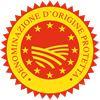Description
Roccaverano PDO or Robiola di Roccaverano PDO is a soft cheese produced with raw whole goat’s milk. The milk must be obtained from goats belonging to the Roccaverano and Camosciata Alpina breeds and their cross-breeds.
Production Area
The production area of Roccaverano PDO is within the municipalities of Cessole, Loazzolo, Mombaldone, Monastero Bormida, Olmo Gentile, Roccaverano, San Giorgio Scarampi, Serole and Vesime in the Province of Asti, and in the municipalities of Cartosio, Castelletto d’Erro, Denice, Malvicino, Merana, Montechiaro d’Acqui, Pareto, Ponti and Spigno in the Province of Alessandria, in the Piedmont region.
Production Method
The milk comes from consecutive milkings carried out over a period of 24-48 hours. After natural acidification has occurred, animal rennet is added to the milk and it is left to curdle for 8 to 36 hours, depending on the climatic and environmental conditions of the processing area. The sour curd is then transferred into perforated moulds with a base. The whey can be expulsed before the shaping of the cheese, by leaving the curd in a cloth to drip. It remains in the moulds for up to 48 hours, during which time they are turned regularly. Both sides of the product are dry salted, either when the cheese is turned, or at the end of the shaping process. Natural ripening occurs by storing the fresh product in special rooms for at least three days. Roccaverano PDO is considered mature from the 11th day after it was put in the moulds.
Appearance and Flavour
Roccaverano PDO has a cylindrical shape with flat surfaces that are slightly scalloped. Its weight varies from 250 to 400 g and its height from 2.5 to 4 cm. There are two typologies: Fresco (fresh) and Affinata or Stagionata (mature). The fresh cheese is either rind free or has a light natural bloom of mould; the mature cheeses have a straw-yellow or reddish-brown rind. The fresh cheese is fine-grained, creamy and soft, becoming firmer with aging. The colour varies from milky white to cream and/or yellow. It has a delicate, flavoursome and slightly acidulous flavour and aroma, which is stronger in the mature cheese.
History
The origins of Roccaverano PDO date back to the Celts, who settled in Liguria and started to make a very similar cheese. Later, with the arrival of the Romans, this cheese took the name rubeola, from the Latin word ruber (red), which indicates the colour acquired by the rind at the end of the ripening process.
Gastronomy
If kept in the refrigerator, Roccaverano PDO should be placed on a porcelain or ceramic plate and covered with a lid of the same material, so that the porosity of the recipient allows the cheese to breathe. In some areas it is preserved in oil. It is an excellent table cheese, both fresh and mature, and is delicious dressed with oil and a pinch of chili pepper. However, it is also used as an ingredient in the fillings of local pastas and savoury flans. The delicacy of fresh robiola requires a white wine with character, even mature and with depth, while mature robiolas pair well with structured red wines, late harvest wines and passito wines.
Marketing
The product is marketed year-round as Roccaverano PDO or Robiola di Roccaverano PDO, in two typologies: Fresco (aged 4-10 days) and Affinata or Stagionata (aged at least 11 days). It is sold whole.
Distinctive Features
The characteristic flavour of Roccaverano PDO is given to the diet of the goats, which feed on plants of which at least 80% come from the production area of the PDO, thereby producing milk with distinctive aromas. One of the dairies favourite plants is Sainfoin, which gives the cheese a particularly sweet taste.






















